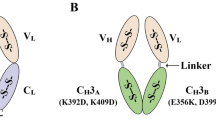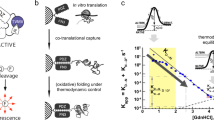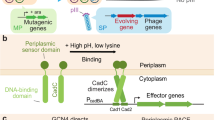Abstract
To create a rapid system to test the effect of sequence changes on recombinant antibody binding, we have developed a procedure for producing functional scFv fragments in an Escherichia coli cell-free translation system. Functional antibodies with antigen-binding activity are obtained only if disulfide formation and rearrangement is allowed to take place during the translation reaction. The inclusion of protein disulfide isomerase (PDI) leads to a threefold increase in yield over that obtained in the presence of glutathione redox systems. DsbA had no such effect, indicating that disulfide shuffling, and not net formation, is the crucial yield-limiting step. The addition of the molecular chaperones DnaK and DnaJ increased the amount of soluble protein but not the amount of functional scFv, which appears to be limited entirely by correct disulfide formation. None of these factors significantly influenced total protein synthesis. In the presence of PDI, chaperones, reduced glutathione and oxidized glutathione, 50% of the scFv produced (about 8 μg/ml in only 15 min) could be recovered from immobilized antigen.
This is a preview of subscription content, access via your institution
Access options
Subscribe to this journal
Receive 12 print issues and online access
$209.00 per year
only $17.42 per issue
Buy this article
- Purchase on Springer Link
- Instant access to full article PDF
Prices may be subject to local taxes which are calculated during checkout
Similar content being viewed by others
References
Hurle, M.R. and Gross, M. 1994. Protein engineering techniques for antibody humanization. Curr. Opin. Biotechnol. 5: 428–433.
Plückthun, A. 1992. Mono- and bivalent antibody fragments produced in Escherichia coli: engineering, folding and antigen binding. Immunol. Rev. 130: 151–188.
Trill, J.J., Shatzman, A.R., and Ganguly, S. 1995. Production of monoclonal anti-bodies in COS and CHO cells. Curr. Opin. Biotechnol. 6: 553–560.
Goto, Y. and Hamaguchi, K. 1979. The role of the intrachain disulfide bond in the conformation and stability of the constant fragment of the immunoglobulin light chain. J. Biochem. 86: 1433–1441.
Glockshuber, R., Schmidt, T., and Plückthun, A. 1992. The disulfide bonds in anti-body variable domains: effects on stability, folding in vitro, and functional expres-sion in Escherichia coli. Biochemistry 31: 1270–1279.
Holmgren, A. 1985. Thioredoxin. Ann. Rev. Biochem. 54: 237–271.
Freedman, R.B., Hirst, T.R., and Tuite, M.F. 1994. Protein disulfide isomerase: building bridges in protein folding. Trends Biochem. 19: 331–336.
Freedman, R.B. 1995. The formation of protein disulphide bonds. Curr. Op. Struct. Biol. 5: 85–91.
Laboissière, M.C.A., Sturley, S.L., and Raines, R.T. 1995. The essential function of protein-disulfide isomerase is to unscramble non-native disulfide bonds. J. Biol. Chem. 270: 28006–28009.
Tachibana, C. and Stevens, T.H. 1992. The yeast EUG1 gene encodes an endo-plasmic reticulum protein that is functionally related to protein disulfide iso-merase. Mol. Cell. Biol. 12: 4601–4611.
LaMantia, M.L. and Lennarz, W.J. 1993. The essential function of yeast protein disulfide isomerase does not reside in its isomerase activity. Cell 74: 899–908.
Bardwell, J.C.A., McGovern, K., and Beckwith, J. 1991. Identification of a protein required for disulfide bond formation in vivo. Cell 67: 581–589.
Kamitani, S., Akiyama, Y., and Ito, K. 1992. Identification and characterization of an Escherichia coligene required for the formation of correctly folded alkaline phosphatase, a periplasmic enzyme. EMBO J. 11: 57–62.
Guilhot, C., Jander, G., Martin, N.L., and Beckwith, J. 1995. Evidence that the path-way of disulfide bond formation in Escherichia coliinvolves interactions between the cysteines od DsbB and DsbA. Proc. Natl. Acad. Sci. USA 92: 9895–9899.
Kishigami, S., Kanaya, E., Kikuchi, M., and Ito, K. 1995. DsbA-DsbB interaction through their active site cysteines. Evidence from an odd cysteine mutant of DsbA. J. Biol. Chem. 270: 17072–17074.
Missiakas, D., Georgopoulos, C., and Raina, S. 1994. The Escherichia colidsbC (xprA) gene encodes a periplasmic protein involved in disulfide bond formation. EMBO J. 13: 2013–2020.
Zapun, A., Missiakas, D., Raina, S., and Creighton, T.E. 1995. Structural and functional characterization of DsbC, a protein involved in disulfide bond forma-tion in Escherichia coli. Biochemistry 34: 5075–5089.
Missiakas, D., Schwager, F., and Raina, S. 1995. Identification and characteriza-tion of a new disulfide isomerase-like protein (dsbD) in Escherichia coli. EMBO J. 14: 3415–3424.
Hartl, F.U. 1996. Molecular chaperones in cellular protein folding. Nature 381: 571–579.
Huston, U.S., Levinson, D., Mudgett-Hunter, M., Tai, M.-S., Novotny, J., Margolies, M.N. et al. 1988. Protein engineering of antibody binding sites: recov-ery of specific activity in an anti-digoxin single-chain Fv analogue produced in Escherichia coli. Proc. Natl. Acad. Sci. USA 85: 5879–5883.
Schulze-Gahmen, U., Rini, J.M., and Wilson, I.A. 1993. Detailed analysis of the free and bound conformations of an antibody. X-ray structures of Fab 17/9 and three different Fab-peptide complexes. J. Mol. Biol. 234: 1098–1118.
Nicholls, P.J., Johnson, V.G., Andrew, S.M., Hoogenboom, H.R., Raus, J.C.M., and Youle, R.J. 1993. Characterization of single-chain antibody (sFv)-toxin fusion proteins produced in vitro in rabbit reticulocyte lysate. J. Biol. Chem. 268: 5302–5308.
Proba, K., Ge, L., and Plückthun, A. 1995. Functional antibody single-chain fragments from the cytoplasm of Escherichia coli: influence of thioredoxin reductase (TrxB). Gene 159: 203–207.
Wunderlich, M., Otto, A., Seckler, R., and Glockshuber, R. 1993. Bacterial protein disulfide isomerase: Efficient catalysis of oxidative protein folding at acidic pH. Biochemistry 32: 12251–12256.
Darby, N.J. and Creighton, T.E. 1995. Catalytic mechanism of DsbA and its com-parison with that of protein disulfide isomerase. Biochemistry 34: 3576–3587.
Darby, N.J. and Creighton, T.E. 1995. Functional properties of the individual thiore-doxin-like domains of protein disulfide isomerase. Biochemistry 34: 11725–11735.
Lyles, M.M. and Gilbert, H.F. 1991. Catalysis of the oxidative folding of ribonu-clease A by protein disulfide isomerase: dependence of the rate on the compo-sition of the redox buffer. Biochemistry 30: 613–619.
Song, J.L. and Wang, C.C. 1995. Chaperone-like activity of protein disulfide isomerase in the refolding of rhodanese. Eur. J. Biochem. 231: 312–316.
Quan, H., Fan, G., and Wang, C.C. 1995. Independence of the chaperone activ-ity of protein disulfide isomerase from its thioredoxin-like active site. J. Biol. Chem. 270: 17078–17080.
Roth, R.A. and Pierce, S.B. 1987. In vivo cross-linking of protein disulfide isomerase to immunoglobulins. Biochemistry 26: 4179–4182.
Liberek, K., Marszalek, J., Ang, D., Georgopoulos, C., and Zylicz, M. 1991. Escherichia coli DnaJ and GrpE heat shock proteins jointly stimulate ATPase activity of DnaK. Proc. Natl. Acad. Sci. USA 88: 2874–2878.
Langer, T., Lu, C., Echols, H., Flanagan, J., Hayer, M.K., and Hartl, F.U. 1992. Successive action of DnaK, DnaJ and GroEL along the pathway of chaperone-mediated protein folding. Nature 356: 683–689.
Buchberger, A., Schröder, H., Büttner, M., Valencia, A., and Bukau, B. 1994. A conserved loop in the ATPase domain of the DnaK chaperone is essential for stable binding of GrpE. Nature Struct. Biol. 1: 95–101.
Frydman, J., Nimmesgern, E., Ohtsuka, K., and Hartl, F.U. 1994. Folding of nascent polypeptide chains in a high molecular mass assembly with molecular chaperones. Nature 370: 111–117.
Munro, S. and Pelham, H.R.B. 1986. An Hsp70-like protein in the ER: identity with the 78 kd glucose-regulated protein and immunoglobulin heavy chain binding protein. Cell 46: 291–300
Melnick, J., Dul, J.L., and Argon, Y. 1994. Sequential interaction of the chaper-ones BiP and GRP94 with immunoglobulin chains in the endoplasmic reticulum. Nature 370: 373–375.
Beckmann, R.P., Mizzen, L.E., and Welch, W.J. 1990. Interaction of Hsp 70 with newly synthesized proteins: implications for protein folding and assembly. Science 248: 850–854.
Nelson, R.J., Ziegelhoffer, T., Nicolet, C., Werner-Washburne, M., and Craig, E.A. 1992. The translation machinery and 70 kD heat shock protein cooperate in protein synthesis. Cell 71: 97–105.
Hendrick, J.P., Langer, T., Davis, T.A., Hartl, F.U., and Wiedmann, M. 1993. Control of folding and membrane translocation by binding of the chaperone DnaJ to nascent polypeptides. Proc. Natl. Acad. Sci. USA 90: 10216–10220.
Tokatlidis, K., Friguet, B., Deville-Bonne, D., Baleux, F., Fedorov, A.N., Navon, A., et al.1995. Nascent chains: folding and chaperone interaction during elongation on ribosomes. Phllos. Trans. R. Soc. Lond. B. Biol. Sci. 348: 89–95.
Spirin, A.S., Baranov, V.I., Ryabova, L.A., Ovodov, S.Yu., and Alakhov Yu, B. 1988. A continuous cell-free translation system capable of producing polypep-tides in high yield. Science 242: 1162–1164.
Prodromou, C. and Pearl, L.H. 1992. Recursive PCR: a novel technique for total gene synthesis. Prot. Eng. 5: 827–829.
Freund, C., Ross, A., Guth, B., Plückthun, A., and Holak, T.A. 1993. Characteri-zation of the linker peptide of the single-chain Fv fragment of an antibody by NMR spectroscopy. FEBS Lett. 320: 97–100.
Gurevich, V.V., Pokrovskaya, I.D., Obukhova, T.A., and Zozulya, S.A. 1991. Preparative in vitro mRNA synthesis using SP6 and T7 RNA polymerases. Analyt. Biochem. 195: 207–213.
Chen, H.-Z. and Zubay, G. 1983. Prokaryotic coupled transcription-translation. Methods Enzymol. 101: 674–690.
Ryabova, L.A., Vinokurov, L.M., Shekhovtsova, E.A., Alakhov Yu, B., and Spirin, A.S. 1995. Acetyl phosphate as an energy source for bacterial cell-free systems. Analyt. Biochemistry 226: 184–186.
Lindner, P., Guth, B., Wülfing, C., Krebber, C., Steipe, B., Müller F., and Plückthun, A. 1992. Purification of native proteins from the cytoplasm and periplasm of Escherichia coli using IMAC and histidine tails: a comparison of proteins and protocols. Methods: A Companion to Meth. Enzymol. 4: 41–56.
Laemmli, U.K. 1970. Cleavage of structural proteins during the assembly of the head of bacteriophage T4. Nature 227: 680–685.
Kitagawa, T., Kanamaru, T., Wakamatsu, H., Kato, H., Yano, S., and Asanuma, Y. 1978. A new method for preparation of an antiserum to penicillin and its application for novel enzyme immunoassay of penicillin. J. Biochem. 84: 491–494.
Author information
Authors and Affiliations
Corresponding author
Rights and permissions
About this article
Cite this article
Ryabova, L., Desplancq, D., Spirin, A. et al. Functional antibody production using cell-free translation: Effects of protein disulfide isomerase and chaperones. Nat Biotechnol 15, 79–84 (1997). https://doi.org/10.1038/nbt0197-79
Received:
Accepted:
Issue Date:
DOI: https://doi.org/10.1038/nbt0197-79
This article is cited by
-
A rapid cell-free expression and screening platform for antibody discovery
Nature Communications (2023)
-
Applications of synthetic biology in medical and pharmaceutical fields
Signal Transduction and Targeted Therapy (2023)
-
Towards a generic prototyping approach for therapeutically-relevant peptides and proteins in a cell-free translation system
Nature Communications (2022)



